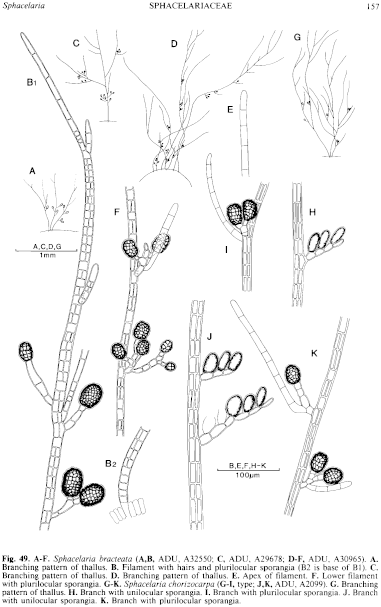|
|
|
|
|
|||||||||||
|
Electronic Flora of South Australia Species Fact Sheet
Phylum Phaeophyta – Order Sphacelariales – Family Sphacelariaceae
Selected citations: Womersley 1967: 195.
Synonyms
S. pulvinata var. bracteata Reinke 1891: 17, pl. 5 fig. 11.
S. pulvinata sensu De Toni 1895: 508 (in part). Harvey 1863, synop.: XIV. Lucas 1909: 19. Reinke 1890: 209 (in part). Sonder 1881: 9. Tisdall 1898: 501. S. pygmaea Lenormand ex Sauvageau 1900: 255 (R30), fig. 9A.
S. foecunda Sauvageau 1900: 259 (R34), fig. 9C,D,G.
Thallus (Fig. 49A,C,D) medium brown, 1–3 mm long, forming small tufts or mats on the branches of Cystophora spp. with the base of each axis penetrating the host meristoderm individually. Branching (Fig. 49A,C,D) sparse, rare in young plants to occasional in larger plants, irregular, with laterals emitted at narrow angles; phaeophycean hairs absent to common. Axes (Fig. 49B,F) (8–) 12–18 (–20) µmin diameter with segments L/B (0.6–) 1–1.5 (–2), laterals of similar dimensions or slightly less; longitudinal walls (one, rarely two) present in most segments, absent in occasional segments and near apices (Fig. 49E) and base of filaments; secondary transverse walls absent or rare; pericysts present or inconspicuous.
Reproduction: Reproduction by ovoid plurilocular sporangia (Fig. 49B,F) borne either directly on the branches or axillary on a short to long, usually uniseriate filament, at first singly on a 1–4 celled pedicel but becoming compound by branching from the pedicel with 2–7 sporangia; sporangia (20–) 25–40 (–55) Atm long and 18–30 µm in diameter. Unilocular sporangia unknown.
Type from southern Australia, on Cystophora subfarcinata; in Herb. Sauvageau, PC (fragment), and in Herb. Reinbold, M (?).
Selected specimens: Avoid Bay (near Coffin Bay), S. Aust., drift on C. racemosa (Womersley, 30.xi.1975; ADU, A46827). Aldinga, S. Aust., drift on C. congesta and C. retroflexa (Womersley, 29.vii.1966; ADU, A30647-"Marine Algae of southern Australia" No. 149a and ADU, A30648-"Marine Algae of southern Australia" No. 149b respectively). Seal Bay, Kangaroo I., S. Aust., drift on C.racemosa (Womersley, 29.x.1966; ADU, A30965-"Marine Algae of southern Australia" No. 33, incorrectly as S. chorizocarpa).Victor Harbor, S. Aust., drift on C. polycystidea (Womersley, 14.xi.1965; ADU, A29678) and upper sublittoral on C. retorta (Womersley, 14.vii.1968; ADU, A32550-"Marine Algae of southern Australia" No. 32). Sorrento, Vic., upper sublittoral on C. siliquosa (Bennett, Nov. 1949; ADU, A15267). Swansea, Tas., drift on C. grevillei (Womersley, 19.i.1949; ADU, A10227).
Distribution: On various species of Cystophora, from Avoid Bay, S. Aust. to Sorrento, Vic. and around Tasmania.
Taxonomic notes: S. bracteata is a fairly common epiphyte on several species of Cystophora, and was recognised by Sauvageau under several specific names. It was first described by Reinke as a variety of the New Zealand S. pulvinata Hooker & Harvey, but elevated by Sauvageau to a distinct species on account of the branching of the erect filaments and the possession of plurilocular sporangia. As well as S. bracteata, Sauvageau described S. pygmaea Lenormand ex Sauvageau from Port Phillip and S. foecunda from Victoria, as closely related species which he separated on height, the position of the plurilocular sporangial clusters, and on the hair pedicels. These were reduced to synonymy under S. bracteata by Womersley (1967, p. 195) and the differences recognised by Sauvageau are only due to age and development of the plants and the sporangial clusters. Specimens ascribed to the above species are only known with plurilocular sporangia.
S. bracteata probably occurs on Cystophora in New Zealand. It differs from S. pulvinata Hooker & Harvey ex Harvey (1855b, p. 221, pl. 110c) which occurs on a different host (Carpophyllum) as more distinct pulvinate tufts, and has almost unbranched filaments with a series of pedicellate unilocular sporangia borne unilaterally along the filaments, with also a more prominent apical cell.
References:
DE TONI, G.B. (1895). Sylloge Algarum omnium hucusque Cognitarum. Vol. 3. Fucoideae. pp. 1–638. (Padua.)
HARVEY, W.H. (1855b). Algae. In Hooker, J.D., The Botany of the Antarctic Voyage. Part II. Flora Novae-Zelandiae. Vol. 2, pp. 211–266, Plates 107–121.
HARVEY, W.H. (1863). Phycologia Australica. Vol. 5, Plates 241–300, synop., pp. 1–73. (Reeve: London.)
LUCAS, A.H.S. (1909). Revised list of the Fucoideae and Florideae of Australia. Proc. Linn. Soc. N.S. W. 34, 9–60.
REINKE, J. (1890) Uebersicht der bisher bekannten Sphacelariaceen. Ber. Deutsch. Bot. Ges. 8, 201–215.
REINKE, J. (1891). Beiträge zur vergleichenden Anatomie und Morphologie der Sphacelariaceen. Bibl. Bot. 23, 1–40, Plates 1–13.
SAUVAGEAU, C. (1900–1914). Remarques sur les Sphacélariacées. This was published as follows: pp. 1–51, J. de Bot. 14 (1900); pp. 51–167, Ibid. 15 (1901); pp. 167–228, Ibid. 16 (1902); pp. 228–332, Ibid. 17 (1903); pp. 332–348, Ibid. 18 (1904); pp. 348–480? (1904) and pp. 481–634 (1914), separately published with the above reprinted, 1914. (Bordeaux.)
SONDER, O.W. (1881). In Mueller, F., Fragmenta Phytographiae Australiae. Supplementum ad volumen undecinum: Algae Australianae hactenus cognitae. pp. 1–42, 105–107.
TISDALL, H.T. (1898). The algae of Victoria. Rep. 7th Meet. Aust. Ass. Adv. Sci., Sydney, 1898, pp. 493–516.
WOMERSLEY, H.B.S. (1967). A critical survey of the marine algae of southern Australia. II. Phaeophyta. Aust. J. Bot. 15, 189–270.
The Marine Benthic Flora of Southern Australia Part II complete list of references.
Publication:
Womersley, H.B.S. (14 December, 1987)
The Marine Benthic Flora of Southern Australia
Part II
©Board of the Botanic Gardens and State Herbarium, Government of South Australia
Illustration in Womersley Part II, 1997: FIG. 49 A–F.

Figure 49 enlarge
Fig. 49. A–F. Sphacelaria bracteata (A,B, ADU, A32550; C, ADU, A29678; D–F, ADU, A30965). A. Branching pattern of thallus. B. Filament with hairs and plurilocular sporangia (B2 is base of B1). C. Branching pattern of thallus. D. Branching pattern of thallus. E. Apex of filament. F. Lower filament with plurilocular sporangia. G–K. Sphacelaria chorizocarpa (G–I, type; J,K, ADU, A2099). G. Branching pattern of thallus. H. Branch with unilocular sporangia. I. Branch with plurilocular sporangia. J. Branch with unilocular sporangia. K. Branch with plurilocular sporangia.

|
Email Contact: State Herbarium of South Australia |

|